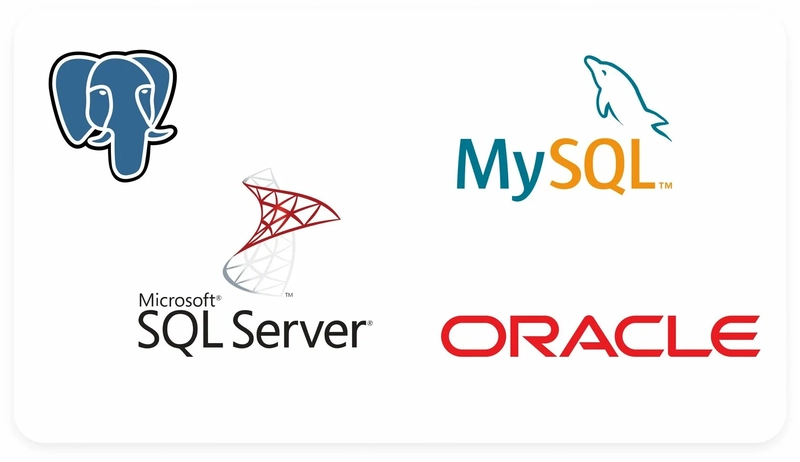📌 Introduction
Structured Query Language, commonly abbreviated as SQL, is the de facto standard for managing and manipulating relational databases. Initially developed at IBM in the early 1970s, SQL has evolved into a powerful tool that enables developers, analysts, and administrators to interface with data effectively.
SQL is more than just a querying language—it is the critical bridge between raw data and business insights. From simple data retrievals to complex transactional systems, SQL continues to power the backend of countless enterprise and cloud systems.
🎯 Key Features of SQL
- Declarative Syntax – Focuses on what to retrieve rather than how.
- Data Integrity – Enforces strict rules via constraints, keys, and transactions.
- Powerful Queries – Supports aggregations, joins, nested queries, etc.
- Cross-Platform Compatibility – Works with MySQL, PostgreSQL, SQL Server, Oracle, and SQLite.
- ACID Compliance – Ensures reliable transactions in multi-user environments.
🔧 SQL Syntax Basics
- Creating a Table
CREATE TABLE Employees (
EmployeeID INT PRIMARY KEY,
FirstName VARCHAR(50),
LastName VARCHAR(50),
Department VARCHAR(50),
Salary DECIMAL(10, 2)
);
- Inserting Data
INSERT INTO Employees (EmployeeID, FirstName, LastName, Department, Salary)
VALUES (1, 'John', 'Doe', 'Engineering', 75000.00);
- Reading Data
SELECT FirstName, LastName, Department
FROM Employees
WHERE Salary > 50000;
- Updating Data
UPDATE Employees
SET Salary = Salary * 1.10
WHERE Department = 'Engineering';
- Deleting Data
DELETE FROM Employees
WHERE EmployeeID = 1;
🔗 SQL Joins: Combining Data Across Tables
👇 Example: Inner Join
SELECT Employees.FirstName, Departments.DeptName
FROM Employees
INNER JOIN Departments
ON Employees.Department = Departments.DeptID;
Joins enable data normalization, reducing redundancy while allowing relational queries that piece together essential insights.
📊 Aggregations & Grouping
SQL provides robust aggregation functions such as COUNT(), SUM(), AVG(), MIN(), and MAX().
SELECT Department, AVG(Salary) AS AverageSalary
FROM Employees
GROUP BY Department;
🔒 Transactions & Data Integrity
BEGIN TRANSACTION;
UPDATE Accounts
SET Balance = Balance - 100
WHERE AccountID = 1;
UPDATE Accounts
SET Balance = Balance + 100
WHERE AccountID = 2;
COMMIT;
Ensuring atomicity, consistency, isolation, and durability (ACID), transactions are fundamental for maintaining data integrity.
🧱 Common SQL Constraints
Here are the most frequently used constraints in SQL and their purposes:
| Constraint | Description |
|---|---|
PRIMARY KEY |
Uniquely identifies each record in a table. |
FOREIGN KEY |
Links records in one table to the primary key in another table. |
UNIQUE |
Ensures all values in a column are different (no duplicates). |
NOT NULL |
Prevents null (empty) values from being inserted into a column. |
CHECK |
Ensures that values in a column satisfy a specific condition or expression. |
DEFAULT |
Assigns a default value to a column when no value is specified. |
🧠 Tip: Proper use of constraints improves data integrity, enforces business rules, and minimizes errors.
🚀 Advanced Topics
- Stored Procedures
- Triggers
- Views
- Indexes for Optimization
- User-defined Functions (UDFs)
These features empower organizations to encapsulate business logic within the database itself—promoting efficiency and control.
🌐 Real-world Applications
- Web development (e.g., e-commerce systems)
- Enterprise Resource Planning (ERP)
- Data Warehousing & BI
- Healthcare and banking
- Cybersecurity logs and forensics
✅ Conclusion
SQL remains timeless in its utility, offering unmatched capabilities in managing structured data. Whether you're building a scalable backend or querying millions of records, mastering SQL is indispensable for today’s data professionals.
🔍 "In the world of data, SQL is not just a language—it's the universal translator."




Top comments (0)